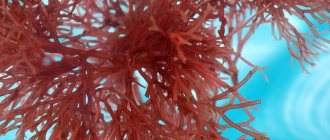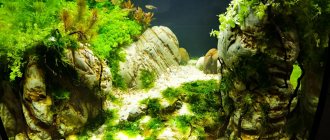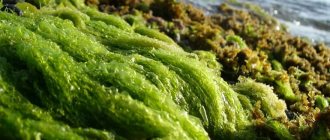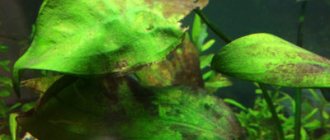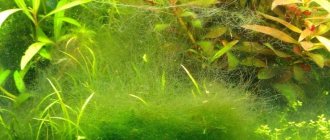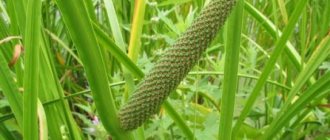Aquarium algae is not at all the same as underwater plants. The latter bring practical benefits: they serve as a substrate for spawning or shelter for swimming fish, food, a biological filter, or simply a decorative item. As for algae, they appear regardless of a person’s desire - they spoil the external beauty of the aquarium and clog the filter. They must be fought. Let's look at the main types of algae in the aquarium and their characteristics.
What it is?
These are the lowest representatives of the underwater world. Individual microorganisms living in an aquatic environment. Algae appear and multiply beyond the owner's wishes. Moreover, an excess of green “parasites” can suffocate everything under water. This will eventually turn into a real nightmare.
Common features
Algae appear on their own based on biological processes occurring in the container. Often their occurrence is influenced by the acquisition of new underwater vegetation or feeding the fish with live food.
Algae are diverse:
• by location – free-floating or attached to surfaces; • by color – green, red, black, blue, pink, purple; • in shape – fluffy tuft, mucous coating, spread carpet; • by growth method – filamentous, branching, layered, flat; • in size - from those that can only be seen under a microscope, to 10 meters in length (in the wild).
What distinguishes algae from underwater plants is that they do not have distinct leaves, stems or rhizomes.
Why are plants needed in an aquarium?
These plants have many options:
- Fish food;
- Spawning area;
- Saturation of water with oxygen;
- Shelter for certain types of fish and underwater inhabitants;
- Reducing the “parasitic” population.
The presence of such plants greatly simplifies the care of the aquarium. However, this is not an integral part of aquarium life. Many people plant plants just to fill voids and add flair to the design.
When choosing plants, you need to take into account the behavior of the fish. So, the same plant is not suitable for different types of fish. They will either eat it or get poisoned.
Amateur aquarists are better off starting with easy-to-care plants.
Titles:
- Lemna (duckweed or herbaceous perennial).
- Vallisneria (vallisneria).
- Elodea (elodea).
- Ceratophyllum (hornwort).
- Limnobium (limnobium) and others.
The main thing is to choose those plants that underwater inhabitants will get along with.
Lemna
Vallisneria
Elodea
Ceratophyllum
Limnobium
Flowering water from Euglena green
Some algae significantly degrade the appearance of the aquarium. Quite often, such artificial mini-reservoirs infect organisms widespread in nature, known as green euglena.
When these organisms multiply, the water becomes cloudy and begins to bloom. This contributes to the disruption of the internal balance in the aquarium ecosystem. The oxygen level in blooming water decreases, which negatively affects the fish and other animals living in such an artificial ecosystem.
The appearance of blooming water is most often observed in spring, when the same process is clearly visible in all natural rivers and lakes.
These microscopic algae are a real disaster for the aquarium; plant species suffer greatly. To eliminate blooms, you first need to reduce the light intensity. It is advisable to cover the aquarium with a cloth for 2-3 days.
This will not cause any harm to fish and plants, but microscopic green organisms will die. Next, I remove about a third of the water present in the aquarium. It is replaced with a new one. This will prevent stagnation and allow the restoration of a normal microclimate in this artificial ecosystem.
Types of aquarium algae
Brown protozoa
One of the safest types of “unplanned” plants. You can notice them in new tanks until the processes in the water normalize. Silicon likes to form on the inside of glass, pipes and artificial decor. They are easy to clean with a regular sponge.
Chlorophyta or multicellular greens
A type of algae that has a thread-like structure in different shades of green. Small accumulations do not pose a threat. If you start the propagation process, the planted plants may die. Competition for nutrients will begin. This type can be removed with your hands or with a net, as these are parasites floating on the surface.
Cyanobacteria or blue-green
This is already a very dangerous species of protozoan plants. Another name is cyanobacteria. Even a small amount of these bacteria is extremely detrimental to the entire ecosystem of the underwater world.
A favorable environment for reproduction is water of poor quality. They form almost everywhere. The color of bacterial plaque varies from blue-green to dark brown. In addition, these parasites contribute to the appearance of a disgusting odor from the water.
It’s easy to get rid of them at the initial stage of development.
Batrachospermum or primitive reds
They have a thread-like structure that floats and covers everything underwater. Their accumulation begins to resemble beautiful algae shrubs or brush-like growths. If measures to get rid of them are not taken in time, they will fill everything around. Then it will be almost impossible to get them out.
Signs of xenococcus and how to fight it
This green algae from the aquarium looks very remarkable. It forms colonies in the form of small circles. Excessive lighting is a provoking factor for increasing their numbers. It is extremely difficult to remove colonies of these green algae that are localized on glass.
It is generally impossible to do this with plants.
In order to remove these microorganisms, it is better to act comprehensively. First, you should catch all the inhabitants and drain all the water. Severely damaged plant leaves must be removed. Using hydrogen peroxide, you can completely clean the glass in an aquarium. In addition, special cleaning agents can be used to eliminate these algae.
Next, new water is poured into the aquarium. It is imperative to reduce the length of daylight to 8 hours. However, in most cases, if xenococus has already appeared in the aquarium, it is not possible to completely eliminate it in the future. If there are frequent repeated bursts of reproduction of these plants, it is best to start using a special chemical treatment.
The drug Sidenx copes well with these algae.
Its dose must be adequate, so before use it is necessary to carefully study the instructions. In the future, you will have to periodically clean the glass from existing small colonies of these microorganisms.
Underwater pest control
The approach to getting rid of pests should be comprehensive.
Necessary:
- Choose the right location for the aquarium;
- Monitor the light and water temperature;
- Change water if necessary;
- When changing the water, the decor and equipment can also be cleaned;
- Make sure that there are no food particles left in the water;
- Plant plants that help reduce the risk of algae development;
- Monitor the level of phosphates and nitrates.
You need to care for your pond wisely.
Algae forms in an aquarium if:
- Too much light. It is necessary to regulate the length of daylight hours.
- Little light. It may be the "wrong" lamp. Before purchasing lighting fixtures, you should consult with a specialist to determine the correct spectrum of the lamp. Diatom pests like to breed under such an “incorrect lamp” (mainly in new aquariums).
- Dirty water.
- The process of decomposition of dead organic matter in water.
- Poor fluid filtration. Perhaps compressors and filters cannot cope with contamination. It is necessary to monitor the quality of their work and, if necessary, change them.
When using algae control products, you must strictly follow all recommendations.
Advice for beginners: when buying an aquarium, you need to get contacts of professionals who can explain: how to care for plants; what to add to algae in an aquarium to get rid of it; How do algae appear in an aquarium? It is strongly recommended not to turn the aquarium and its inhabitants into an experimental testing ground.
Common diseases
Most hydrobionts are sensitive indicators of environmental conditions. Lack of lighting, macro- and microelements, and temperature fluctuations affect the appearance and growth of plants.
Main symptoms
Symptoms that require immediate correction of living conditions:
- yellowing - deficiency of iron, phosphates;
- lightening of the plate and darkening of the veins - lack of magnesium;
- the appearance of holes with a yellow edge - lack of potassium;
- plate grinding - low temperature;
- decreased growth rate - lack of CO²;
- spoilage of roots - caked, compacted substrate;
- thin, weak, pale stems - lack of light;
- stunted, weak plates - stagnant water.
If algae growth appears on the leaves, it may be due to too much light.
Treatment options
Depending on the cause of the disease, treatment is prescribed.
First of all, you need to compensate for the damaging factor: add the necessary micro- and macroelements, increase/decrease lighting, and change the water.
If the plant continues to hurt, you should continue the diagnosis and find out the cause.

